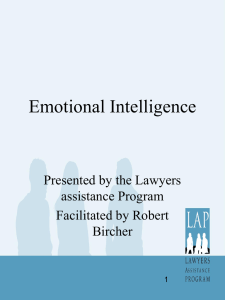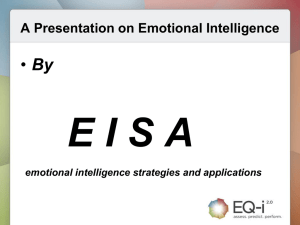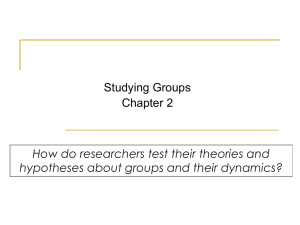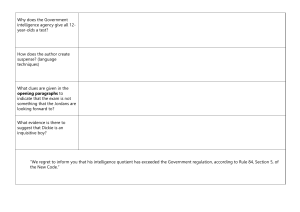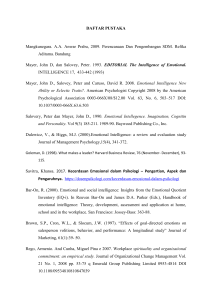Bar-On EQ-i Test Evaluation: Emotional Intelligence Assessment
advertisement
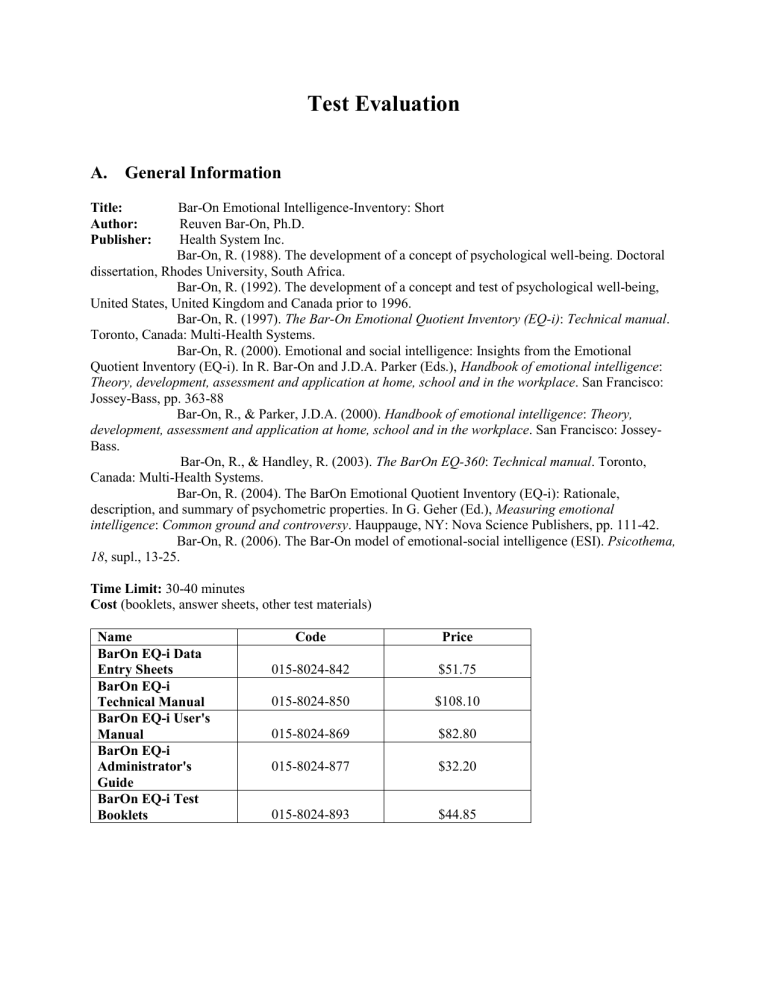
Test Evaluation A. General Information Title: Author: Publisher: Bar-On Emotional Intelligence-Inventory: Short Reuven Bar-On, Ph.D. Health System Inc. Bar-On, R. (1988). The development of a concept of psychological well-being. Doctoral dissertation, Rhodes University, South Africa. Bar-On, R. (1992). The development of a concept and test of psychological well-being, United States, United Kingdom and Canada prior to 1996. Bar-On, R. (1997). The Bar-On Emotional Quotient Inventory (EQ-i): Technical manual. Toronto, Canada: Multi-Health Systems. Bar-On, R. (2000). Emotional and social intelligence: Insights from the Emotional Quotient Inventory (EQ-i). In R. Bar-On and J.D.A. Parker (Eds.), Handbook of emotional intelligence: Theory, development, assessment and application at home, school and in the workplace. San Francisco: Jossey-Bass, pp. 363-88 Bar-On, R., & Parker, J.D.A. (2000). Handbook of emotional intelligence: Theory, development, assessment and application at home, school and in the workplace. San Francisco: JosseyBass. Bar-On, R., & Handley, R. (2003). The BarOn EQ-360: Technical manual. Toronto, Canada: Multi-Health Systems. Bar-On, R. (2004). The BarOn Emotional Quotient Inventory (EQ-i): Rationale, description, and summary of psychometric properties. In G. Geher (Ed.), Measuring emotional intelligence: Common ground and controversy. Hauppauge, NY: Nova Science Publishers, pp. 111-42. Bar-On, R. (2006). The Bar-On model of emotional-social intelligence (ESI). Psicothema, 18, supl., 13-25. Time Limit: 30-40 minutes Cost (booklets, answer sheets, other test materials) Name BarOn EQ-i Data Entry Sheets BarOn EQ-i Technical Manual BarOn EQ-i User's Manual BarOn EQ-i Administrator's Guide BarOn EQ-i Test Booklets Code Price 015-8024-842 $51.75 015-8024-850 $108.10 015-8024-869 $82.80 015-8024-877 $32.20 015-8024-893 $44.85 B. Description: The Bar-On Emotional Intelligence is composed of interpersonal, intrapersonal, stress, adaptability, general mood, inconsistency, and the total emotional quotient. According to Bar-On Emotional Intelligence is a multi-factorial array of emotional and social competencies that determine how effectively we relate ourselves and others and cope with daily demands and pressures. As such, our emotional intelligence is an important factor in determining our ability to succeed in life. General type of test: self-report Population: from 16 years to 93 of age Nature of content: verbal Subtests and separate scores: The EQ-i comprises 133 items in the form of short sentences and employs a 5-point response scale with a textual response format ranging from "very seldom or not true of me" (1) to "very often true of me or true of me" (5). The EQ-i is suitable for individuals 17 years of age and older. Based on the Flesch formula of readability, the reading level in English has been assessed at the North American sixth grade level. It takes approximately 40 minutes to complete the inventory; and it typically takes less time to complete the online version than the paper-and-pencil version of the instrument. Item types: It consists of fifty-one (51) items distributed across eight (8) scales: inconsistency index, positive impression scale, total emotional quotient, interpersonal EQ, stress management EQ, adaptability EQ, and general mood EQ. C. Practical Evaluation Qualitative features of test materials (e.g. design of test booklet, editorial quality of content, ease of using, attractiveness, durability, appropriateness for test takers): The comprehensive Technical Manual provides detailed information about the administration, scoring, interpretation, development, norming, reliability, and validity of Bar-On EQ-i®. The concise User's Manual is ideal for professionals who require only essential information on the administration, scoring, and interpretation. The Facilitator's Guide explains how to properly interpret and give feedback to respondents. The Administrator's Guide provides users with step-by-step information on administration procedures, maintaining confidentiality, and obtaining informed consent. The Technical Manual is required for information on administration, scoring, and interpretation. The User's Manual, Administrator's Guide, and Facilitator's Guide are recommended for all EQ-i®. For Mail-In/Fax-In scoring, you will need Mail-In/Fax-In Response Sheets (specify Individual Summary, Development, or Resource) and Item Booklets (reusable). Administration: Bar-On Emotional Intelligence-i-S is a practical and efficient instrument that is simple to administer and score. A respondent can complete the inventory in about 30-40 minutes. And the test administrator can score and profile the responses in less than 15 minutes using a Quick-Score tm and profile form. Respondents completing the instrument make their responses on a “special MultiHealth Systems Quick-Score” forms are used to score the various scales. The results are then transferred to Profile Sheet. The profile sheet then allows for display of the individual’s test results and facilitates comparisons with his or her specific normative groups. The conversion of raw scores to standard scores is easy using the profile sheet. No special scoring templates are needed since all scoring information is provided on the Quick-Score form. Separate forms are available for males and females within different age groups. Scoring procedures: The effectiveness of this component has been confirmed by the fairly high degree of overall correlation (R=.69) between observer ratings of the behavior assessed by the EQ-i and the scores of 185 individuals who completed this instrument. The findings of this study are summarized in the BarOn EQ-360: Technical Manual and will be briefly discussed below when describing the EQ-360. Moreover, findings from the same study empirically demonstrate that the difference between the self-report and other-observer assessment of EI is negligible when using the EQ-i. Raw scores on the EQ-i are automatically tabulated and converted into standard scores based on a mean of 100 and standard deviations of 15. This scoring system resembles that which is used by cognitive intelligence tests that generate an IQ (or Intelligence Quotient), which is exactly what I had in mind when I coined the term “EQ” (“Emotional Quotient”) during my doctoral studies in the mid 1980s. Average to above average scores on the EQ-i suggest that the respondent is effective in emotional and social functioning, meaning that he or she is most likely emotionally and socially intelligent. The higher the scores, the more positive the prediction for effective functioning in meeting environmental demands and pressures. On the other hand, an inability to be effective in performing well and the possible existence of emotional, social and/or behavioral problems are suggested by low scores. Significantly low scores on the following subscales indicate the potential for serious difficulties in coping on a daily basis: Stress Tolerance, Impulse Control, Reality Testing, and Problem Solving. Examiner Qualifications and training required: The technical and functional skills listed below are based on general qualifications for EQ Examiners commonly recognized by most people. Typically, you will not be required to have all of the skills listed to be a successful performer. . 1. Motivating, developing, and directing people. Using scientific rules and methods to solve problems. 2. Considering the relative costs and benefits of potential actions to choose the most appropriate one. 3. Giving full attention to what other people are saying, taking time to understand the points being made, asking questions as appropriate, and not interrupting at inappropriate times. 4. Talking to others to convey information effectively. 5. Using logic and reasoning to identify the strengths and weaknesses of alternative solutions, conclusions or approaches to problems. 6. Understanding the implications of new information for both current and future problem solving and decision-making. . 7. Communicating effectively in writing as appropriate for the needs of the audience. Licensure as Psychological Examiner demands experience in a special education or counseling setting, satisfactory completion of the required graduate coursework and practicum, plus a passing score on the 'Praxis II Special Education: Knowledge-Based Core Principles'. Graduate school recommendation and verification of experience by the employing school district complete the requirements. An annual professional development plan and ongoing performance-based evaluation ensure 'High Quality' professionalism as required by the No Child Left Behind law and related regulations. D. Technical Evaluation: 1. Norms The normative sample for Bar-On EQ of 3174 (1543 males and 1631 females) range in age from 16 to 93 years of age. The mean age for males was 35.52 years with a standard deviation of 11.68 and 34.41 for females with a standard deviation of 12.14. 2. Reliability The Bar-On Emotional Quotient used internal consistency refers to the degree to which all items on a particular scale consistently measure the same construct. The internal consistency of a particular scale is a function of both the quality of the scale items a as well as the validity of a respondent’s answer. Internal consistency coefficients range from .76 to .93, with the exception of Positive Impression scale. Test-retest reliability refers to the stability of responses to the same items over time. The stability of Bar-On EQ was examined using the test-retest interval of 6 months in a sample of 352 adults (73 man and 279 women) Stability coefficient for Bar-On EQ Scale by gender based on a Retest period of Six Months: Scale Positive impression Total Emotional Quotient Intrapersonal Interpersonal Stress Management Adaptability General Mood Males .60 .72 .80 .57 .69 .61 .60 Females .46 .80 .77 .61 .76 .57 .79 In general, test-retest reliabilities for the Bar-On EQ scales are excellent ranging from .46 to .80 3. Validity The validity of an instrument is the extent to which it measures the construct that it was designed to measure. The primary objective is to demonstrate that the instrument has construct validity. 1. 2. 3. The Bar-On EQ has the following findings: The extent to which the scales structure of Bar-On EQ makes sense empirically and theoretically (factorial analysis); The degree to which the Bar-On EQ scale correlates with the other measures purported to assess similar construct (construct validity). The ability of the Bar-on EQ to predict behaviors that one would expect to be related to emotional intelligence (predictive validity). Bar-On EQ Emotional Quotient-i-S demonstrates sufficient factorial construct and predictive validity to warrant publication and recommendations for use in various setting such as business, educational, clinical or medical, and research settings. E. Review Comments: F. Summary Evaluation The Emotional Quotient Inventory (EQ-i®) is the first scientifically validated and most widely used Emotional Intelligence assessment in the world. Based on more than 20 years of research worldwide, the EQ-i examines an individual’s social and emotional strengths and weaknesses. Respondents self-report on their life and workplace performance in 15 key areas of emotional skill that have been proven to contribute to proficiency in complex business activities such as conflict resolution and planning. By identifying the areas that need improvement, the client can immediately begin developing those areas. At the same time, areas where the client excels can be leveraged to their full potential to maximize effectiveness in daily tasks. Skills associated with emotional intelligence are acquired and can be improved through training, making BarOn EQ-i® a valuable instrument for identifying potential areas for improvement and for measuring the effectiveness of organizational development programs.
